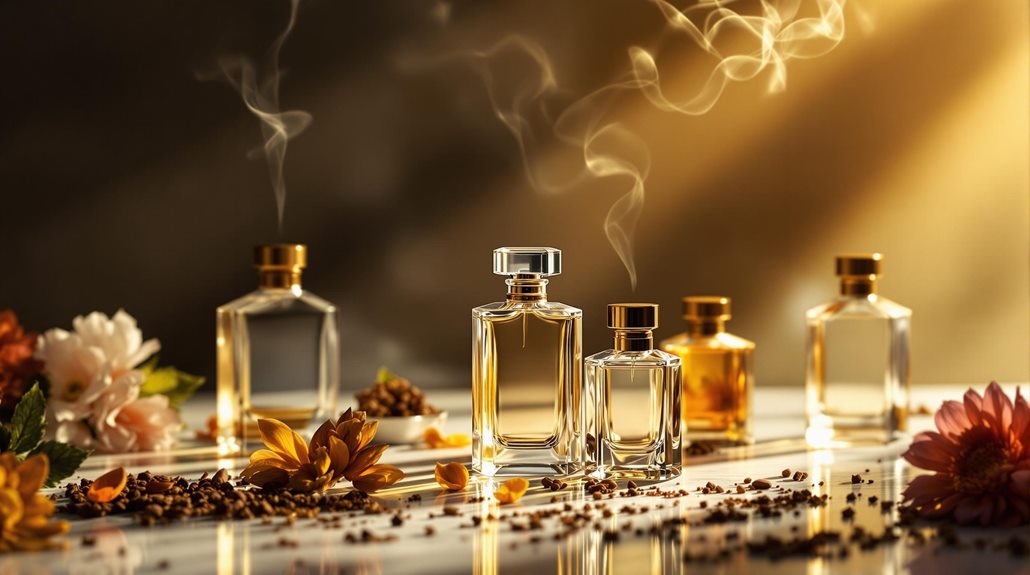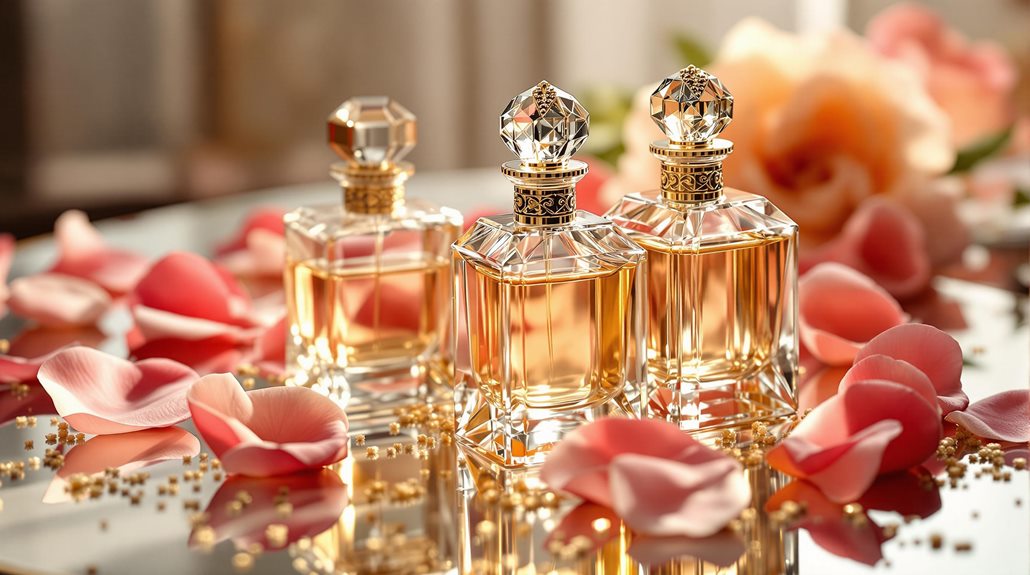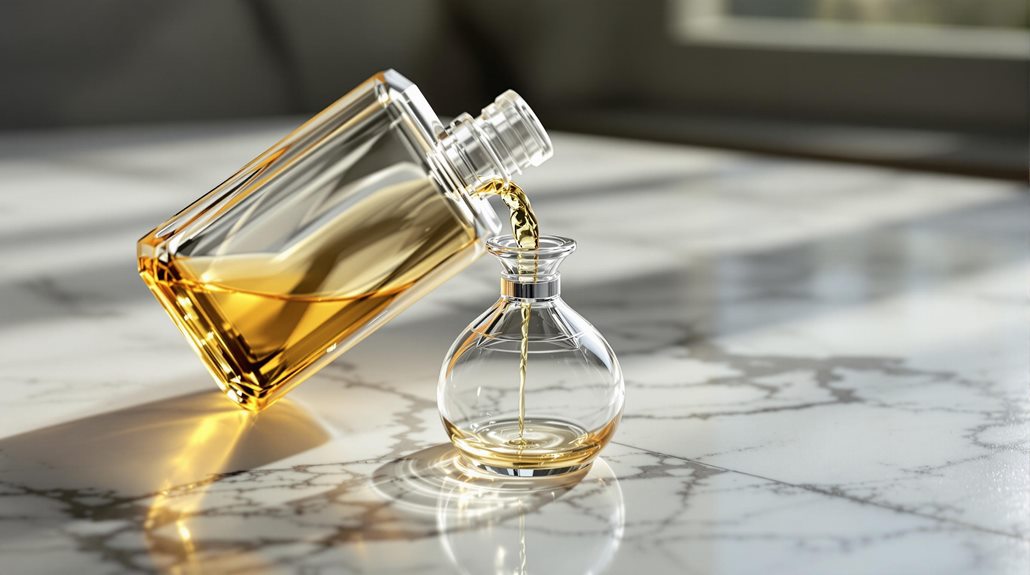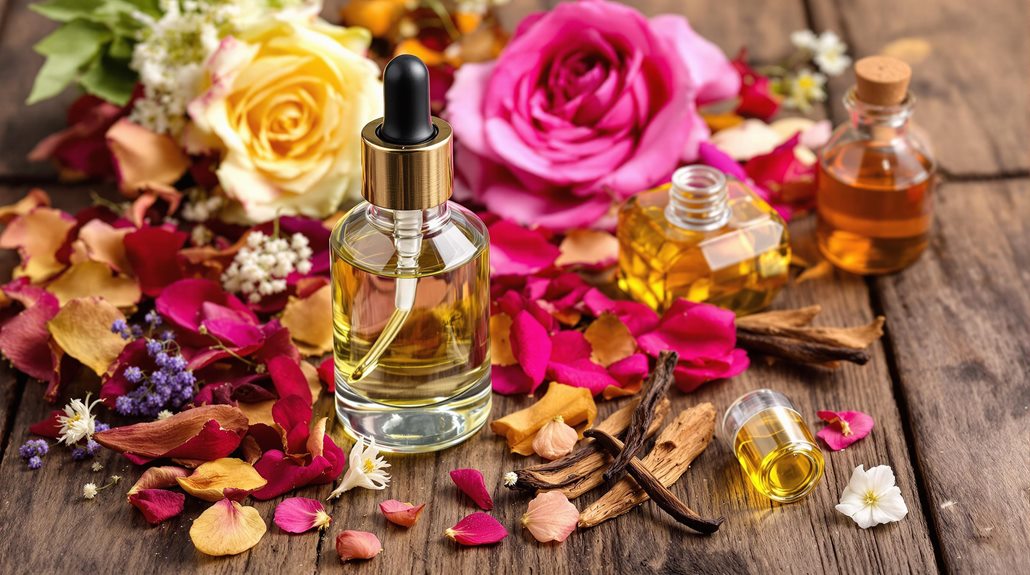What Is Oud Perfume? The Rich History and Allure of Oud Fragrance
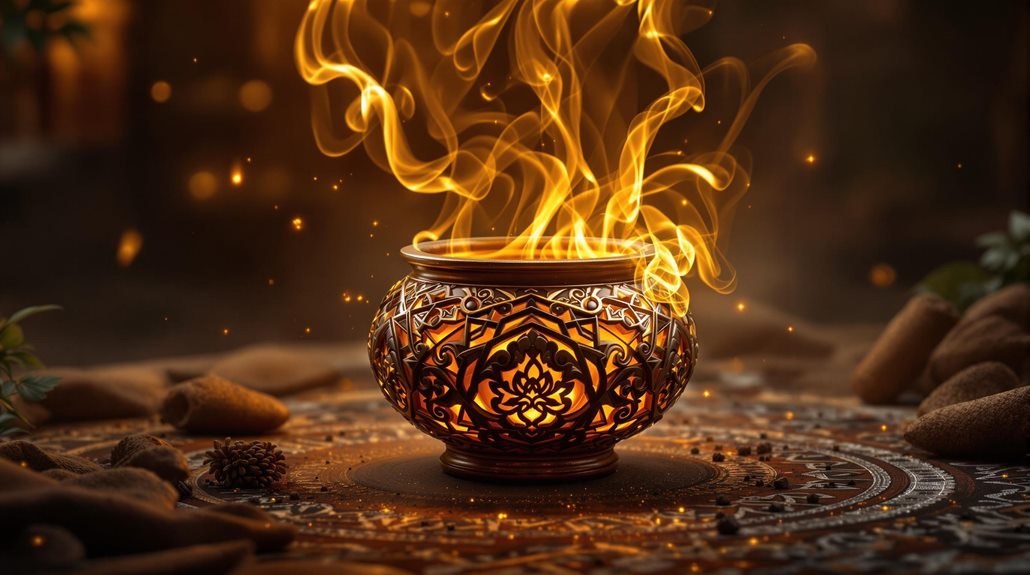
Oud perfume comes from the precious resinous heartwood of Southeast Asian Aquilaria trees, where it's been treasured for over 3,000 years. You'll find this "wood of the gods" deeply rooted in Middle Eastern spiritual ceremonies and cultural traditions. The fragrance delivers a warm, intense, and earthy character that's uniquely alluring, with complex notes ranging from sweet and rich to smoky and animalic. Due to its rarity - only 10% of Aquilaria trees produce it naturally - genuine oud commands astronomical prices up to $50,000 per pound. Today's growing popularity in Western perfumery reveals just the beginning of oud's fascinating expedition.
The Origins of Oud
Deep within the heart of Southeast Asia's Aquilaria trees lies one of perfumery's most precious treasures: oud. This highly sought-after fragrant substance begins its odyssey when the Aquilaria tree becomes infected, triggering the production of a dark, aromatic resin within its core. What you're experiencing in oud perfume is actually the result of the tree's natural defense mechanism.
The story of this precious ingredient dates back to 1400 BC, making it one of the oldest known fragrance materials in human history. You'll find that the process of obtaining oud resin remains rooted in traditional methods, requiring skilled artisans to carefully extract the resinous heartwood by hand. This fastidious process, combined with the rarity of properly infected Aquilaria trees, explains why genuine oud is one of the world's most expensive natural materials.
The significance of this Southeast Asian treasure extends far beyond perfumery. Throughout history, civilizations have prized agarwood not only for its intoxicating scent but also for its role in traditional medicine and spiritual practices, cementing its status as a truly astonishing natural phenomenon.
Understanding Oud's Sacred Heritage
Spirituality intertwines deeply with oud's legacy, particularly across the Middle East where it's revered as the "wood of the gods." You'll find this precious resin burning in mosques, temples, and homes during religious ceremonies, where it's believed to create a sacred bridge between the earthly and divine domains.
The alluring scent of oud carries profound cultural significance beyond its luxurious appeal. When you burn oud incense, you're participating in a tradition that's been practiced for centuries, aimed at purifying spaces and elevating spiritual experiences. In Middle Eastern households, you'll notice oud's presence in daily rituals, from scenting clothing and hair to creating an atmosphere of tranquility during meditation and prayer.
What makes oud particularly special in spiritual practices is its ability to alter ordinary moments into sacred experiences. You'll uncover that this precious resin doesn't just serve as a fragrance - it's a spiritual tool that's deeply embedded in religious ceremonies and cultural traditions. Whether used in its raw form or as incense, oud continues to play a fundamental role in connecting people to their spiritual heritage.
The Art of Oud Production
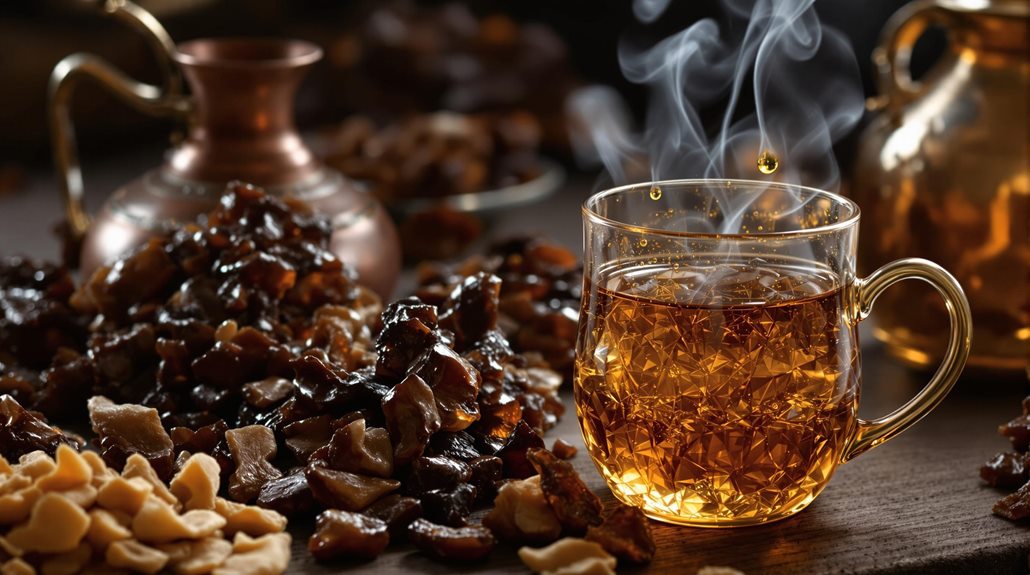
The coveted oud oil emerges through a painstaking process that begins with the Aquilaria tree's heartwood. You'll find these trees scattered across Southeast Asia, but here's what makes them truly noteworthy: only about 10% naturally develop the resinous substance that creates precious oud. This rarity is a key factor in why oud fragrances command such astronomical prices in today's market.
The labor-intensive process involves skilled artisans who carefully identify and hand-carve the infected portions of the heartwood. Once they've extracted these important sections, they'll process the wood through distillation or melting to obtain the dark, viscous oud oil. What you might not know is that this oil isn't ready for use immediately - it needs to age for several years to develop its full character.
The oud smell you'll experience can vary dramatically based on the specific Aquilaria trees and their origin. When you encounter natural oud, you might detect anything from sweet, floral notes to deep, smoky undertones. With raw agarwood fetching up to $100,000 per kilogram, it's no wonder oud is considered one of perfumery's most cherished ingredients.
Oud's Complex Scent Profile
While the production process gives birth to this precious oil, it's oud's extraordinary scent profile that enthralls perfume enthusiasts worldwide. When you experience the scent of oud in modern Eau de Parfum creations, you'll uncover a complex symphony of woody notes that's both enthralling and enigmatic. Natural ingredients like genuine oud deliver a warm, intense, and earthy character that's uniquely alluring.
The versatility of oud perfumes allows perfumers to create diverse olfactory experiences through careful ingredient pairing. You'll find that natural oud can manifest in several distinctive ways:
- Sweet and rich profiles derived from specific Aquilaria species
- Smoky and balsamic variations that offer depth and complexity
- Warm and animalic characteristics that create an unmistakable sensual presence
When you're exploring oud fragrances, you'll notice that synthetic alternatives tend to present a sweeter, nuttier interpretation with less of the animalic qualities found in natural oud. This precious ingredient's multifaceted nature makes it an exceptional base note, providing perfumers with endless possibilities to craft unique and sophisticated scent experiences that continue to enthrall fragrance enthusiasts around the world.
Why Oud Commands Premium Prices
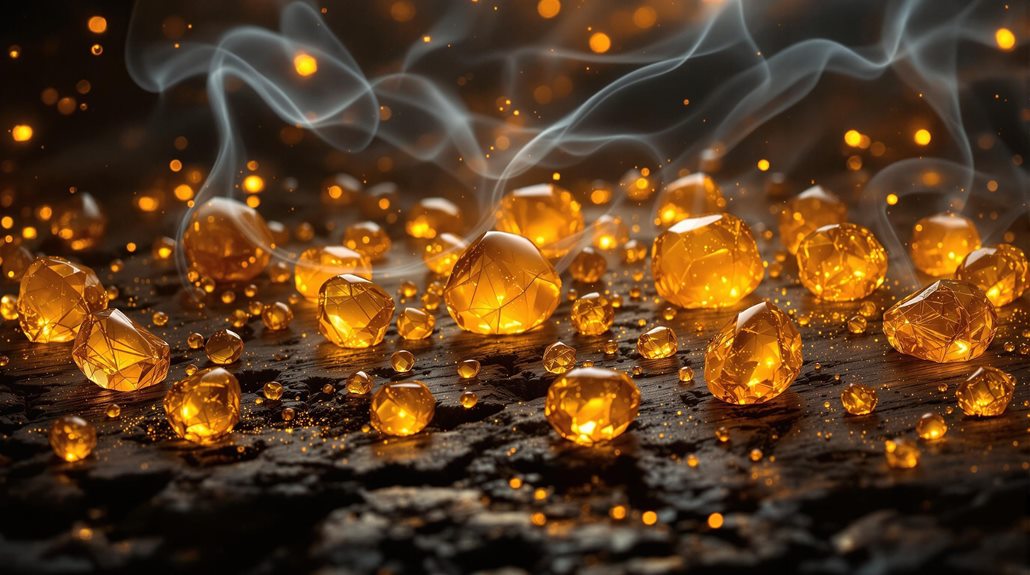
Several key factors drive oud's astronomical prices in the fragrance market. The heartwood of the aquilaria tree, native to Southeast Asia, produces this precious resin through a rare natural process. You'll find that only about 10% of these trees naturally develop the resinous deposits used in perfumery, making natural oud exceptionally scarce.
When you consider that oud can cost up to $100,000 per kilogram, you'll understand why prestigious fragrances like Maison Francis Kurkdjian Oud Satin Mood command such high prices. The intensive labor required to extract and process the resin significantly impacts the cost of natural ingredients. Artisans must carefully hand-carve the infected woodchips to preserve the indispensable resinous sections.
The aquilaria tree's protected status has further magnified oud's market value. As Southeast Asian forests face increasing pressure, sustainable harvesting has become imperative yet challenging. While synthetic alternatives now exist, true oud remains one of perfumery's most precious components. This combination of natural scarcity, labor-intensive processing, and growing global demand continues to push oud prices higher, cementing its status as one of the world's most esteemed fragrance ingredients.
Regional Variations and Characteristics
Beyond its market value, oud's entrancing allure lies in its diverse regional characteristics. As a prized ingredient in perfumery, the origins of oud can be traced through Southeast Asia, where different species of aquilaria trees yield distinctly unique Eastern scents. You'll notice how a blend of oud from Laos carries different aromatic notes compared to those from China, with each variety telling its own rich history through fragrance.
Notable regional varieties include:
- Vietnamese oud, which has evolved uniquely due to historical events like the Vietnam War affecting local aquilaria populations
- Chinese Aquilaria sinensis, known as oud with predominantly woody undertones that linger on the skin
- Laotian Aquilaria crassna, producing oil with distinctive herbal characteristics
When you're exploring Oud Wood fragrances, you'll explore that natural variations can range from sweet and floral to deep and balsamic, depending on their source and processing methods. While synthetic alternatives tend to offer sweeter, less animalic interpretations, they can't fully replicate the complex character of naturally extracted oud, which varies significantly based on its geographical origins and extraction processes.
Modern Oud in Western Perfumery
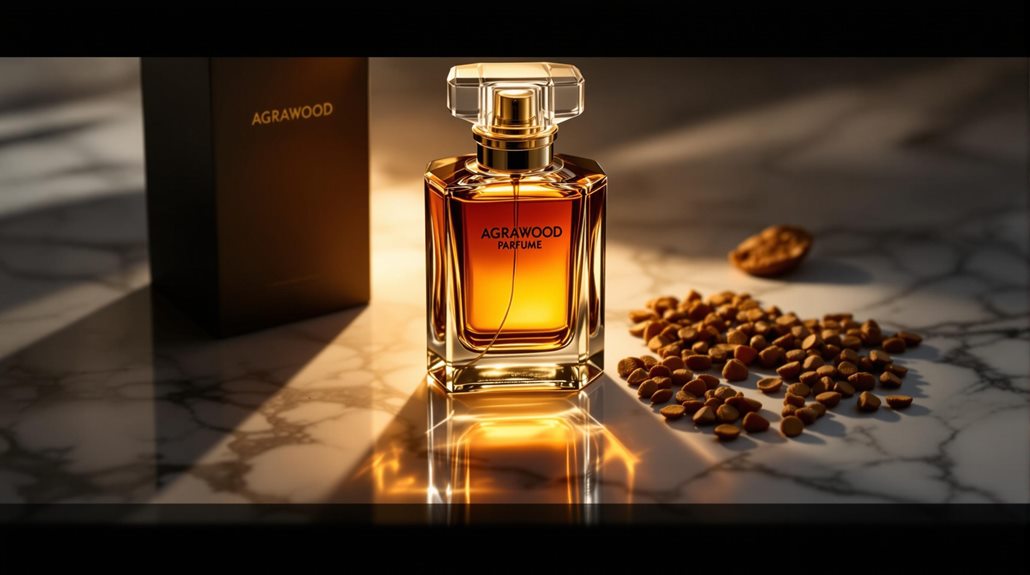
Over the past decade, oud has shifted from an exotic Middle Eastern essence into a cornerstone of Western luxury perfumery. Originally found in Southeast Asia, this precious natural ingredient has captured the imagination of Western perfume houses, with searches for oud fragrances projected to grow by 20% in the next year.
The allure of oud has inspired prestigious brands to incorporate this complex note into their collections. You'll find exceptional interpretations in Francis Kurkdjian Oud Satin, Tom Ford Oud, and Byredo Oud, each showcasing unique ways to blend this intense ingredient to create modern masterpieces. Even Jo Malone London has entered the world of oud, demonstrating how versatile this note can be in contemporary perfumery. The dramatic increase in oud fragrance launches, from just 6 in 2007 to over 200 by 2019, reflects its growing popularity. Social media has amplified this trend, with millions of views on oud-related content across platforms. Western perfumers are particularly drawn to oud's brooding, intimate character and its powerful diffusion, making it an increasingly sought-after ingredient in luxury fragrances.
Identifying Quality Oud Fragrances
With oud's rising popularity in Western perfumery, distinguishing high-quality oud fragrances from mass-market alternatives has become increasingly important. When you're seeking authentic oud-based fragrances, you'll want to look for perfumes that showcase the history of oud through their use of natural ingredients, particularly genuine fragrant resin derived from agarwood chips.
The most luxurious scent compositions from houses like Tom Ford Oud and Amouage demonstrate how this expensive raw material can be used as a fixative while maintaining its distinctive character. You'll notice that authentic oud perfumes offer a complex, multi-layered experience that synthetic alternatives simply can't match.
To identify quality oud fragrances, look for these key indicators:
- A rich, deep aroma that evolves over time, revealing different aspects of the oud's natural complexity
- Clear indication of the oud's source region (such as Laos or Cambodia) on premium products
- Balanced composition where complementary notes enhance, rather than obscure, the oud's characteristic profile
The best oud perfumes will showcase this precious ingredient's full depth while maintaining harmony with other carefully selected fragrance elements.
Conclusion
Whether you're new to oud or a seasoned collector, you'll investigate this precious ingredient offers an unmatched sensory expedition. From its ancient roots to modern luxury perfumes, oud's complex character continues to fascinate fragrance enthusiasts worldwide. If you're ready to delve into this cherished scent, start with authentic sources and take time to appreciate oud's rich heritage and metamorphic power.

